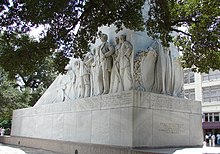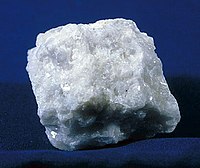User:Sphartan/Alamo Cenotaph
| This is not a Wikipedia article: It is an individual user's work-in-progress page, and may be incomplete and/or unreliable. For guidance on developing this draft, see Wikipedia:So you made a userspace draft. Find sources: Google (books · news · scholar · free images · WP refs) · FENS · JSTOR · TWL |


The Alamo Cenotaph, also known as the Spirit of Sacrifice, is a monument built in celebration of the centenary of the battle, and bears the names of all who are known to have fought there on the Texas side. It is located across the street from the Alamo in San Antonio, Texas.
History[edit]

[1]Though there had been previous plans for Alamo monuments, starting in the late nineteenth century, The Alamo Cenotaph was the first such erected in San Antonio. (There had been one previous monument, In Austin, but it was lost in a Capitol fire.) During the 1936 Texas Sesquicentennial celebration, the state of Texas provided $100,000 for the monument, commisioned from local sculptor Pompeo Coppini. San Antonio mayor Maury Maverick held a dedication ceremony on November 11, 1940. The monument was erected in white marble and granite. It was titled Spirit of Sacrifice and incorpates images of the Alamo garrison leaders and the names of known Alamo defenders.
Battle of the Alamo[edit]

[2]After putting down resistance in other regions of Mexico, in the spring of 1836 Santa Anna led a Mexican army back into Texas and marched on San Antonio, intending to avenge the humiliating defeat of Cos and end the Texian rebellion. Texian leader Sam Houston, believing that San Antonio could not be defended against a determined effort by the regular Mexican army, called for the Texian forces to abandon the city.
A volunteer force under the joint command of William Barrett Travis, newly arrived in Texas, and James Bowie, and including Davy Crockett and his company of Tennesseans, and Juan Seguin's company of Hispanic Texan volunteers occupied and fortified the deserted mission, the Alamo, and determined to hold San Antonio against all opposition.
The defenders of the Alamo thus included both Anglo and Hispanic Texans who fought side by side under a banner that was the flag of Mexico with the numerals "1824" superimposed. This was meant to indicate that the defenders were fighting for their rights to democratic government under the Mexican constitution of that year. It was only during the siege that the Texas Congress declared an independent Republic of Texas.
The Battle of the Alamo took place from February 23 to March 6, 1836. At first the battle was primarily a siege marked by artillery duels and small skirmishes. After twelve days Santa Anna, tired of waiting for his heavy artillery and eager for a glorious victory to enhance his reputation, determined to take the Alamo by storm.
Before dawn on March 6, he launched his troops against the walls of the Alamo in three separate attacks. The third attack overwhelmed the defenses of the weak north wall. The defenders retreated to the now famous Long Barracks and the Chapel and fought to the last man. Most historians agree that a handful of the defenders were captured but were executed as rebels on the specific orders of Santa Anna. The deaths of these "Martyrs to Texas Independence" inspired greater resistance to Santa Anna's regime, and the cry "Remember the Alamo" became the rallying point of the Texas Revolution.
Ozzy Osbourne Incident[edit]
[3]In 1982 Ozzy Osbourne, while wearing his future wife Sharon's dress because she had hidden his clothes, drunkenly urinated on the Alamo Cenotaph which was erected in honour of those who died at the Alamo in Texas, across the street from the actual building. A police officer arrested him, and Osbourne was subsequently banned from the City of San Antonio for a decade.
References[edit]
- ^ "History of San Antonio". Wikipedia. Retrieved 19 June 2011.
- ^ "Battle of the Alamo". Wikipedia. Retrieved 19 June 2011.
- ^ "Wikipedia". Ozzy Osbourne. Retrieved 19 June 2011.
External links[edit]

